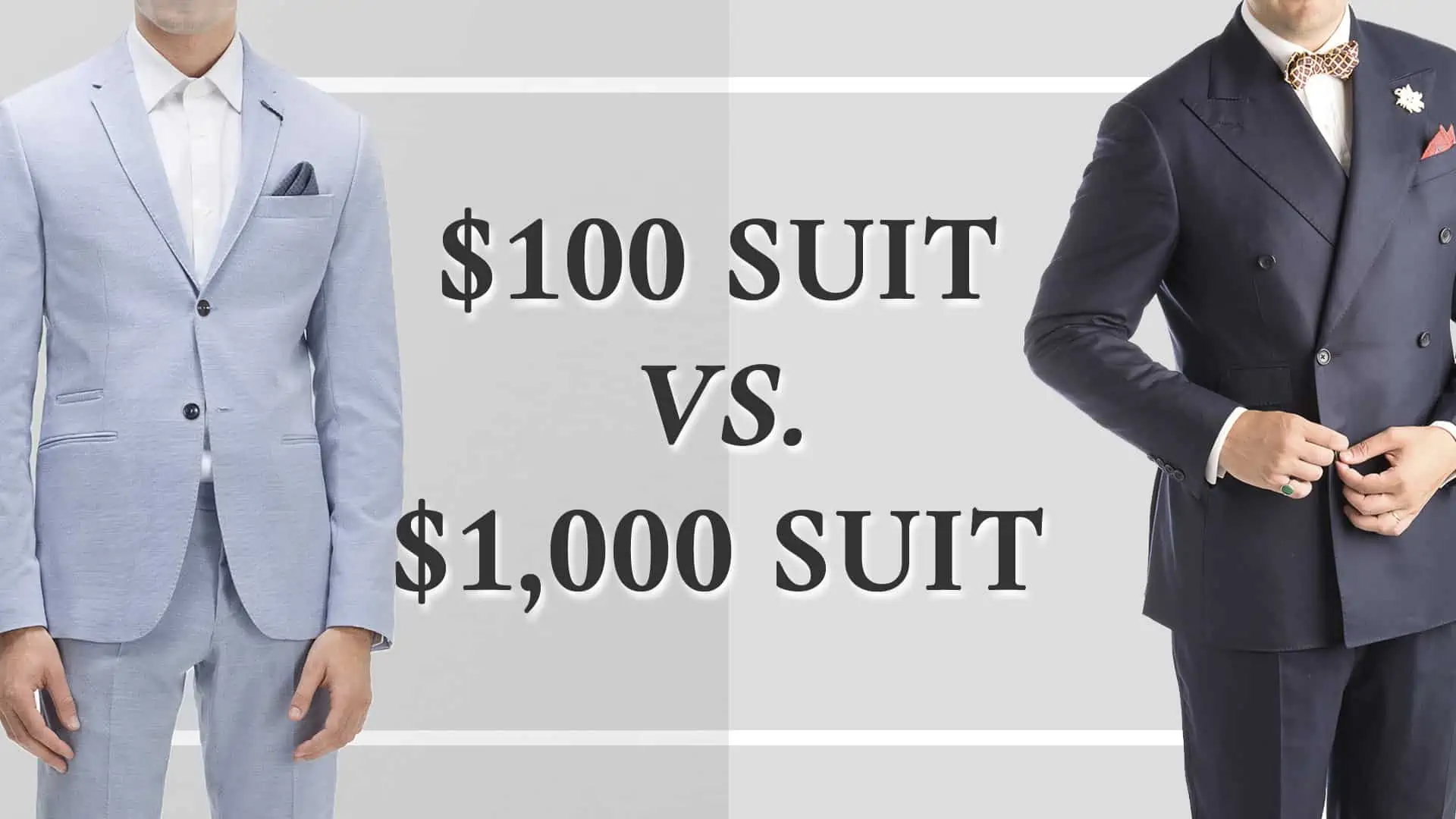So you’ve been considering investing in a new suit, but you’re not quite sure where to start. Well, let’s break it down for you. In this article, we’re going to explore the differences between a $100 suit and a $1000 suit. Now, it’s important to note that the price disparity is not arbitrary – it speaks volumes about the quality and craftsmanship you can expect from each option. While a $100 suit may seem tempting for its affordability, it often falls short in terms of materials, construction methods, and attention to detail. These cheaper suits are typically machine-made, using synthetic fabrics and low-quality interlining. In contrast, a $1000 suit represents the epitome of fine craftsmanship, boasting impeccable attention to detail, and using only the finest materials. The cut and pattern of a $100 suit may be trendy but limited in lifespan, or even outdated, whereas a $1000 suit offers timeless elegance and sophistication. Ultimately, while a budget may be a concern, it’s worth considering the option of buying used or vintage suits for higher quality at a lower price point. So, let’s dive into the world of suits and discover which option suits you best.
Materials
When it comes to the materials used in a suit, there is a noticeable difference between a $100 suit and a $1000 suit.
The $100 suit usually uses cheaper materials, such as synthetic fabrics, that may not have the same level of durability or breathability as higher quality materials. These fabrics can be prone to wear and tear and may not hold up well over time.
On the other hand, the $1000 suit often uses high-quality materials, including natural fabrics like wool or linen. These materials are known for their durability and ability to drape well on the body. They can also provide a more comfortable wearing experience.
In terms of fabric selection, the $100 suit may have limited options and patterns, whereas the $1000 suit offers a wider range of choices, allowing you to find the perfect fabric to suit your personal style.
Construction Methods
The construction methods used in a suit can greatly affect its overall quality and longevity.
In a $100 suit, you will often find that the construction is done by machines. This mass production method can lead to inconsistencies in stitching and less attention to detail. As a result, the overall quality of the suit may be compromised.
On the other hand, a $1000 suit is typically constructed using more traditional and time-consuming methods. Skilled artisans and tailors use techniques like hand stitching to ensure precise and durable seams. This level of craftsmanship not only improves the overall appearance of the suit but also contributes to its longevity.

Quality of Interlining
Interlining plays a crucial role in the structure and shape of a suit. It is the layer of material between the outer fabric and the lining that provides stability and a smooth silhouette.
In a $100 suit, the interlining is often of lower quality. It may be thinner, less supportive, and prone to wrinkling. This can result in a suit that doesn’t hold its shape well and may look less polished.
Alternatively, a $1000 suit usually features a higher quality interlining that provides better structure and support. It helps the suit maintain its shape, preventing wrinkles and ensuring a more tailored fit.
Attention to Details
Attention to detail is a key characteristic that distinguishes a well-made suit from a cheaper alternative.
When it comes to a $100 suit, attention to detail is often lacking. Finer details like hand-stitched buttonholes, pick stitching, and well-matched patterns may be overlooked or substituted with inferior methods. This can result in a suit that looks less refined and may not withstand close scrutiny.
On the other hand, a $1000 suit is crafted with a keen eye for detail. From the placement of buttons to the alignment of patterns, every aspect is carefully considered. This meticulous attention to detail adds a level of sophistication and elegance to the suit.

Craftsmanship
Craftsmanship is an integral part of suit making that can significantly impact the overall quality and appearance.
In a $100 suit, craftsmanship is often compromised due to the mass production methods used. The focus is more on efficiency and speed rather than on creating a meticulously crafted garment. This can result in uneven stitching, loose threads, and overall subpar finishing.
Conversely, a $1000 suit is a testament to skilled craftsmanship. Each garment is carefully handmade, ensuring that every detail is executed with precision. The attention to detail is evident in the neat stitching, clean finishings, and overall superior craftsmanship.
Cut and Pattern
The cut and pattern of a suit are crucial elements that contribute to its overall style and appeal.
In a $100 suit, the cut and pattern may be more influenced by current trends. While this can be appealing for those who want to stay on top of fashion, it may also limit the suit’s lifespan. Trendy patterns and cuts can quickly become outdated, leaving you with a suit that feels out of place.
In contrast, a $1000 suit often offers a more timeless and classic cut. The patterns are carefully selected to provide a versatile and enduring style. This allows the suit to remain stylish and relevant for years to come, ensuring that your investment in a quality suit pays off in the long run.

Lifespan
The lifespan of a suit is an important consideration, especially if you’re looking for a long-term wardrobe staple.
A $100 suit is generally not designed to withstand the test of time. The cheaper materials, construction methods, and attention to detail all contribute to a shorter lifespan. With regular wear, you may find that the suit quickly loses its shape, develops snags or tears, and shows signs of wear and tear.
On the other hand, a $1000 suit is built to last. The high-quality materials, careful construction, and attention to detail ensure a suit that can withstand frequent use and maintain its appearance over an extended period. With proper care, a well-made suit can last for many years, making it a worthwhile investment.
Long-Term Use
If you plan to use a suit for the long term, it’s important to consider the impact of your purchase on your budget.
A $100 suit may seem like an affordable option initially, but when you factor in the shorter lifespan and potential need for replacements, the cost can add up over time. With regular use, you may find yourself needing to replace the suit frequently, ultimately spending more money in the long run.
On the other hand, a $1000 suit, although more expensive upfront, can prove to be a cost-effective choice in the long term. The higher quality materials and craftsmanship ensure durability, allowing you to use the suit for years without needing frequent replacements.

Budget Considerations
If you’re on a tight budget but still want to enjoy the benefits of a higher quality suit, there are alternative options to consider.
A new $100 suit may not offer the same level of quality as a $1000 suit, but it can still be a suitable choice if you need a functional and inexpensive option for occasional wear. While it may not have the same longevity or attention to detail, it can still provide a presentable appearance at an affordable price.
Alternatively, you can explore the option of buying a used or vintage $1000 suit. This can be a cost-effective way to acquire a high-quality suit at a lower price point. Used suits, especially those in good condition, can offer the same level of craftsmanship and materials as a new suit but at a fraction of the cost.
Summary
In summary, the difference between a $100 suit and a $1000 suit lies in the materials, construction methods, quality of interlining, attention to details, craftsmanship, cut and pattern, lifespan, and long-term use. While a $100 suit may be more affordable initially, it often lacks the quality and durability of a $1000 suit. Investing in a higher-priced suit ensures better materials, superior construction, and attention to detail, resulting in a garment that not only looks better but also lasts longer. If budget is a concern, considering used or vintage $1000 suits can provide a cost-effective solution that still delivers on quality. Ultimately, choosing a suit that suits your needs, preferences, and budget will ensure that you look and feel your best for any occasion.

